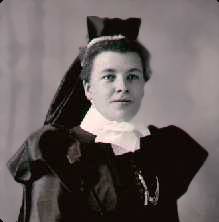In your own collection there are probably images of individuals wearing clothing that puzzles you. Some may be recognizable as work outfits while others remain mysterious. You might have an occupational portrait and not know it because you don’t associate the clothing worn in the picture with a particular job. According to relatives, the woman in this week’s photograph wears a nurse’s uniform.
Peggy Brown owns this picture of her grandmother. No much is known about her except that she met her future husband in Malvern, Worcestershire, England. He immigrated to Saskatchewan, Canada, in 1901 and at some point she followed, marrying him there in 1908. They had two children. Their daughter took an interest in her English heritage and learned that her mother was a nurse and worked as a midwife for a few years in Canada. What puzzles Peggy is that this photograph doesn’t resemble a portrait of her grandfather’s sister in nursing uniform. The second woman wears a white uniform that is typically associated with nursing.
This mystery photograph took some time to solve. The style of clothing she wears dates from the early 1890s based on the short, puffed shoulders on the sleeves. Since a nurse’s cap and uniform identifies where a nurse trained I initially tried finding an institution that collected nursing memorabilia. One such place is the Center for the Study of the History of Nursing at the University of Pennsylvania School of Nursing, 420 Guardian Drive, 307 Nursing Education Building, Philadelphia, PA 19104-6096. The Web site at www.nursing.upenn.edu/history contains photographs of uniforms and a history of nursing. Unfortunately, their curator was unable to help with this particular image.
Since the woman in the image learned nursing in either England or Canada, I contacted The Florence Nightingale Museum, 2 Lambeth Palace Road, London. This museum maintains a collection of nursing memorabilia only for the Nightingale Training School, but the curator offered a few suggestions for identifying the outfit in this photograph. She thought it might be a matron’s uniform since those nurses wore outfits copied from the black dresses worn by Florence Nightingale in Crimea. According to the curator, it is possible that Peggy Brown’s grandmother held a “rank” since only those headdresses had ribbons tied under the chin. If you look closely at the picture, you can see a thin ribbon that extends behind her ear to under her chin. While the curator could not identify which school Peggy’s grandmother attended, she was able to eliminate both St. Thomas Hospital and the Royal London Hospital.
Researching an ancestor’s occupation can help you find out more about them based on employment requirements. For instance, a Web site for nurses, Emergency Nursing World at www.enw.org/1895_Nursing.htm, contains text from Ambulance Work And Nursing: A Handbook On First Aid To The Injured With A Section On Nursing, Etc., which offers insights into the world of British nurses in the 1890s. Nurses had to be “physically and constitutionally” strong with a well-modulated voice and an attractive face. It also helped if they participated in sports and danced well (a sign of good carriage). This text recommended that nurses not only speak their native English well, but a little French and German. This means that Peggy Brown’s grandmother was a healthy strong woman with probably some education.
Occupational images can be challenging to identify because of the amount of research time they require. However, they are generally worth the effort because they reveal when and where a person worked in addition to their job. You also learn more about the time period in which your ancestor lived and his or her everyday life. The other documents you accumulate on that person such as census records may list occupation. With that information you can have fun researching the topic using the Internet and your public library. You might be surprised by what you discover.
A few readers have sent occupational photographs, which I look forward to featuring in future columns as soon as I learn more about them. Please send more! I’m having great time piecing together the clues in these picture puzzles.
Find out how to submit your own picture for possible analysis by Maureen Taylor. E-mail her at mtaylor@taylorandstrong.com.





